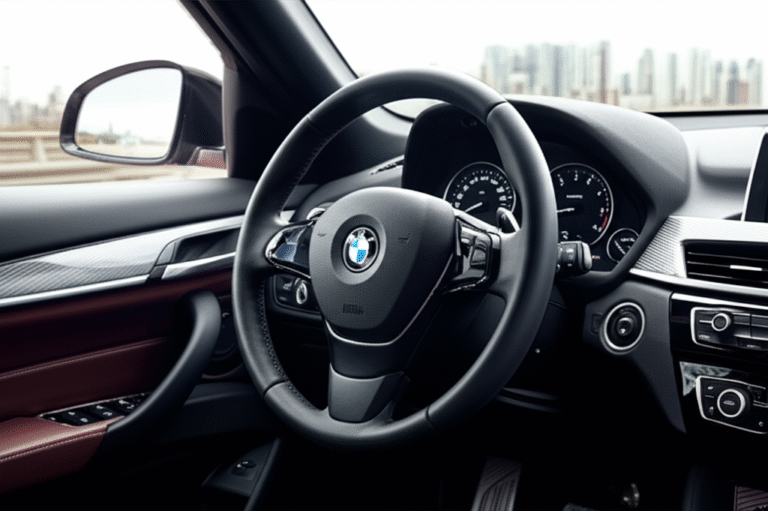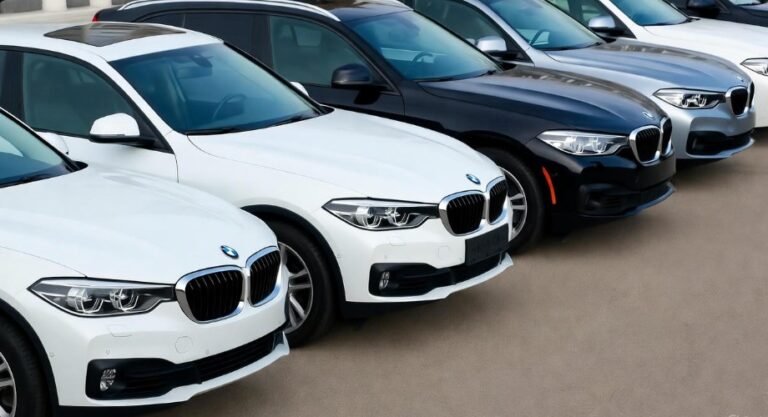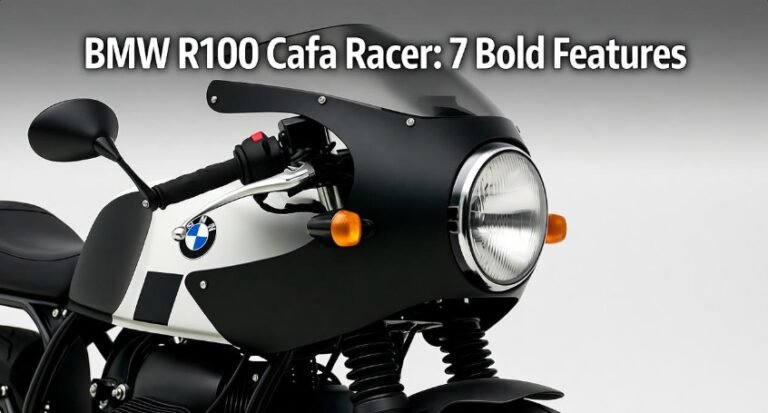BMW S1000rr Tyre Size: 5 Safety Details
BMW S1000RR Tyre Size: 5 Safety Details You Must Know for Peak Performance and Protection.
Choosing the correct tyre size for your BMW S1000RR isn’t just about how your bike looks; it’s a critical factor in your safety and riding experience. Finding the right BMW S1000RR tyre size can seem complicated, especially with all the numbers and codes involved. But don’t worry, we’re here to simplify it for you. Understanding these details ensures your superbike handles as it was designed, keeping you confident and secure on every ride. Let’s delve into the five essential safety details about your BMW S1000RR tyre size.
Key Takeaways
- Ensure correct BMW S1000RR tyre size for optimal handling.
- Never deviate from manufacturer-recommended tyre specifications.
- Understand tyre load and speed ratings for safe operation.
- Check tyre pressure regularly for stability and grip.
- Monitor tyre wear for timely replacement.
Understanding Your BMW S1000RR Tyre Size Code
Your BMW S1000RR tyre size is more than just a set of numbers; it’s a precise specification that dictates how your bike interacts with the road. BMW engineers spent thousands of hours perfecting the balance, handling, and safety of the S1000RR. This means the tyre size is directly tied to its suspension geometry, braking performance, and overall stability. Using the wrong size can have significant, and dangerous, consequences.
The standard tyre sizes for the BMW S1000RR are generally consistent across most model years, though slight variations can occur. The most common sizes you’ll find are:
Front Tyre: 120/70 ZR 17 M/C (58W) TL
Rear Tyre: 190/55 ZR 17 M/C (75W) TL
Let’s break down what each part of this code means. It’s crucial for everyone, from an experienced rider to a new owner, to grasp these specifics to maintain the integrity and safety of their machine.
Decoding the Numbers: Front Tyre Breakdown
Let’s dissect the front tyre code: 120/70 ZR 17 M/C (58W) TL.
- 120: This is the tyre’s width in millimeters. It measures the distance from sidewall to sidewall. A wider tyre might offer more grip in certain conditions, but the S1000RR is designed for a specific width for optimal cornering agility and stability.
- 70: This is the aspect ratio, expressed as a percentage. It represents the tyre’s sidewall height as a percentage of its width. So, 70 means the sidewall height is 70% of 120mm. This ratio significantly impacts how the tyre flexes and responds to steering inputs.
- ZR: This indicates the tyre’s construction. ‘Z’ signifies a speed capability of over 150 mph (240 km/h), which is essential for a superbike like the S1000RR. ‘R’ means it has a Radial construction, where the internal fabric plies run radially across the tyre. Modern tyres predominantly use radial construction for better performance and durability.
- 17: This is the diameter of the wheel rim in inches that the tyre is designed to fit. The S1000RR uses 17-inch wheels.
- M/C: This designation specifies that the tyre is intended for motorcycle use.
- (58W): This is the load and speed index. The number ’58’ is the load index, indicating the maximum weight the tyre can carry at its maximum speed. The ‘W’ is the speed symbol, indicating the maximum speed capability of the tyre. For the S1000RR, ‘W’ typically means a speed rating of up to 168 mph (270 km/h). Always refer to your owner’s manual for the exact load and speed index for your specific model year.
- TL: This stands for Tubeless. Modern motorcycles almost exclusively use tubeless tyres, which are safer as they are less prone to sudden deflation if punctured.
Decoding the Numbers: Rear Tyre Breakdown
Now, let’s look at the rear tyre code: 190/55 ZR 17 M/C (75W) TL.
- 190: This is the width of the rear tyre in millimeters. It’s wider than the front to provide more stability and traction for acceleration.
- 55: This is the aspect ratio. The sidewall height is 55% of the tyre’s width (190mm). A lower aspect ratio generally means a more responsive tyre with less sidewall flex, contributing to sharper handling.
- ZR: Similar to the front, this confirms radial construction and a high-speed rating (over 150 mph).
- 17: The wheel rim diameter in inches.
- M/C: Motorcycle use indicator.
- (75W): The load and speed index. ’75’ is the load index, signifying a higher load capacity than the front tyre. ‘W’ is the speed symbol, again indicating a high-speed capability, typically up to 168 mph (270 km/h), but always verify with your manual.
- TL: Tubeless tyre construction.
5 Crucial Safety Details for Your BMW S1000RR Tyre Size
Beyond the basic code, there are critical safety aspects tied to your BMW S1000RR tyre size that you cannot afford to overlook. These details are paramount for ensuring your bike performs as intended and keeps you safe on the road.
1. Adhering Strictly to Manufacturer Specifications
This is the golden rule. BMW designs the S1000RR with specific tyre sizes for a reason. The chassis geometry, suspension settings, and electronic rider aids (like ABS and traction control) are all calibrated based on the dimensions and characteristics of the stock tyre sizes. Deviating from these specifications can lead to:
- Altered Handling Dynamics: A different tyre width or aspect ratio can change how the bike leans into corners, potentially leading to instability or unpredictable behaviour.
- Compromised Suspension Performance: The suspension is tuned to work with the specific sidewall height and stiffness of the recommended tyres. Incorrect sizes can make the suspension feel too soft or too harsh, reducing its effectiveness.
- Inaccurate Speedometer Readings: A tyre with a significantly different outer diameter will cause your speedometer to read inaccurately, affecting your perceived speed and distance travelled.
- Compromised Electronic Rider Aids: Systems like BMW’s Motorrad ABS and Dynamic Traction Control rely on precise wheel speed data. Incorrect tyre circumferences can send faulty data to these systems, reducing their effectiveness or causing them to malfunction.
Always consult your BMW S1000RR owner’s manual or a trusted BMW dealership for the exact tyre specifications recommended for your specific model year. Don’t guess; verify.
2. Understanding Load and Speed Ratings
The load index (the number) and speed rating (the letter) are non-negotiable safety parameters. The S1000RR is a high-performance machine, and its tyres must be rated to handle the stresses placed upon them during spirited riding and high-speed operation.
- Load Index: The load index tells you the maximum weight the tyre can support. While a solo rider on an S1000RR might not exceed the load rating with the specified tyre, carrying luggage or a passenger (if the bike is designed for it and regulations allow) could push the limits if the tyres are not correctly rated. Exceeding the load capacity can lead to tyre overheating, increased wear, and potential catastrophic failure.
- Speed Rating: The speed rating indicates the maximum speed at which the tyre can safely operate. The ‘W’ rating on S1000RR tyres signifies capability well beyond typical road speeds. Using tyres with a lower speed rating than specified is extremely dangerous. At high speeds, tyres generate significant heat. A tyre not designed for those speeds can overheat, lose structural integrity, and fail suddenly.
When replacing tyres, ensure the new ones have a load index and speed rating that are equal to or greater than the original equipment specifications. You can find charts online that cross-reference speed symbols with actual speeds, but your owner’s manual is the definitive source for your S1000RR.
External Resource: For more information on tyre speed ratings, you can refer to resources like the National Highway Traffic Safety Administration (NHTSA) website, which often provides general guidance on tyre safety and markings.
3. The Critical Importance of Tyre Pressure
Tyre pressure is arguably the single most critical factor in tyre performance and safety, and it’s directly influenced by the tyre size and its intended operation. Incorrect tyre pressure can:
- Reduce Grip and Traction: Underinflated tyres have a larger contact patch but can deform excessively, leading to squirming and reduced feedback. Overinflated tyres have a smaller, harder contact patch, reducing grip and increasing the risk of skidding, especially in wet conditions.
- Affect Handling: Proper pressure ensures the tyre maintains its intended profile. Incorrect pressure can make steering feel heavy or overly sensitive, leading to a loss of control.
- Increase Wear: Underinflation causes excessive wear on the outer edges of the tread, while overinflation wears out the centre of the tread prematurely. Uneven wear compromises the tyre’s performance and lifespan.
- Lead to Overheating: Underinflated tyres flex more, generating excessive heat which can lead to a blowout.
BMW typically specifies different tyre pressures for the front and rear tyres, and sometimes even different pressures for solo riding versus riding with a passenger or luggage. Always check your owner’s manual for the recommended pressures for your specific S1000RR model. A good quality tyre pressure gauge is an essential tool for any rider.
Pro Tip: Check your tyre pressure at least once a week, and always before a long ride. Tyres can lose a few PSI over time, and temperature fluctuations can also affect pressure.
4. Monitoring Tyre Wear and Condition
Tyres are the only point of contact between your BMW S1000RR and the road. As they wear down, their ability to provide grip, brake effectively, and maintain stability diminishes significantly. Regular inspection of your tyres is a vital safety measure.
Tread Depth: Most motorcycle tyres have wear indicators – small raised bars within the main tread grooves. When the tread wears down to the level of these indicators, it’s time for new tyres. The legal minimum tread depth varies by region, but generally, anything less than 1.6mm is considered worn. For superbike performance, it’s wise to replace them well before reaching the absolute legal minimum.
Visual Inspection for Damage: Look for:
- Cuts, cracks, or bulges in the sidewall.
- Embedded objects like nails or glass in the tread.
- Uneven wear patterns (cupping, scalloping, or feathering) which can indicate suspension issues or incorrect pressures.
A damaged tyre, even with plenty of tread, can be dangerous and may fail unexpectedly. If you notice any significant damage or unusual wear, have your tyres inspected by a professional immediately.
5. Selecting the Correct Tyre Type and Compound
Even within the correct size, different tyres are designed for different purposes and riding conditions. For the BMW S1000RR, you’ll typically be looking at high-performance sport or hypersport tyres. Understanding the nuances can enhance your safety and riding experience.
- Sport Tyres: Designed for road use with a focus on grip, feel, and longevity. They offer a good balance for everyday riding and occasional spirited canyon carving.
- Race/Track Tyres (or “Slicks”): These tyres have minimal tread for maximum contact patch and are designed for track use. They often require tyre warmers to reach optimal operating temperature and are not suitable or legal for road use due to their lack of tread.
- Compound: Tyre compounds range from harder, longer-lasting materials to softer, stickier compounds that offer supreme grip but wear out faster. For the S1000RR, a dual-compound tyre is common, featuring a harder compound in the centre for longevity and a softer compound on the shoulders for cornering grip.
Choosing the right tyre type and compound depends on how you use your S1000RR. If you’re primarily a street rider, stick to high-performance sport tyres matched to the OEM specifications. If you plan on track days, consult with tyre specialists about appropriate track-oriented options, but remember you’ll need a separate set of tyres for road use.
BMW S1000RR Tyre Size: A Comparative Look
When you’re looking at replacing your BMW S1000RR tyres, you might encounter various brands and models within the correct size. While the basic dimensions remain constant, subtle differences in construction, tread pattern, and compound can affect performance and feel. Here’s a simplified comparison of what to consider:
| Characteristic | OEM Specification tyres (e.g., Bridgestone Battlax, Michelin Pilot Power) | Aftermarket Sport-Max tyres | Track-focused tyres (road legal) |
|---|---|---|---|
| Intended Use | Road riding, sport touring, spirited riding | Aggressive street riding, occasional track days | Track days, spirited canyon carving (limited road use) |
| Tread Life | Good to Excellent | Good, may be slightly reduced from OEM | Fair to Poor (designed for maximum grip, not mileage) |
| Grip Levels | Excellent for road conditions | Very Good to Excellent, especially at higher lean angles | Exceptional, especially when warm |
| Warm-up Time | Quick | Moderate | Requires tyre warmers for optimal performance on track; longer warm-up on road |
| Price Point | Mid to High | Mid to High | High |
This table illustrates that while the BMW S1000RR tyre size remains the same, the specific tyre chosen can alter your riding experience. Always prioritize safety and consult reviews or professional advice when choosing a new brand or model.
Common Misconceptions About Tyre Size Alterations
It’s common for riders to think about modifying their bike’s setup. However, when it comes to tyre size on a superbike like the S1000RR, misconceptions can be particularly dangerous.
- “A wider tyre always means more grip.” Not necessarily. While grip is crucial, the bike’s suspension and geometry are tuned for a specific width. Too wide a tyre can alter the bike’s profile and make it difficult to lean correctly, reducing overall control and potentially causing the tyre to scrub on parts of the bike it wasn’t designed to.
- “A different aspect ratio will make it turn faster.” While a lower profile tyre (lower aspect ratio) can make a bike feel more responsive, the S1000RR’s engineers selected the 190/55 rear for a reason. Altering this can upset the bike’s balance and stability, especially during braking and acceleration.
- “I can use car tyres on my motorcycle.” This is an absolute myth and incredibly dangerous. Motorcycle tyres and car tyres are fundamentally different in their construction, flexibility, and intended forces. Car tyres are not designed to handle the lean angles and forces experienced by a motorcycle, and using them would lead to immediate loss of control.
Sticking to the manufacturer’s recommended BMW S1000RR tyre size is the safest and most effective way to ensure your bike performs as intended.
Frequently Asked Questions (FAQs)
Q1: Can I use a slightly different tyre size for my BMW S1000RR?
It is strongly advised against using a tyre size that deviates from the manufacturer’s recommendations for your BMW S1000RR. Even minor changes in width or aspect ratio can negatively affect handling, stability, and the performance of your bike’s electronic rider aids.
Q2: What happens if I put a tyre with a lower speed rating on my S1000RR?
Using a tyre with a lower speed rating than specified is extremely dangerous. It significantly increases the risk of tyre overheating, structural failure, and a catastrophic blowout, especially at high speeds. Always ensure your replacement tyres meet or exceed the original speed rating (e.g., ‘W’).
Q3: How often should I check my BMW S1000RR tyre pressure?
You should check your tyre pressure at least once a week, and before any long or spirited rides. Tyres can naturally lose pressure over time, and temperature changes can also affect it. Always refer to your owner’s manual for the correct pressure settings.
Q4: What does ‘TL’ mean on a tyre, and why is it important for my S1000RR?
‘TL’ stands for Tubeless. Modern motorcycles like the S1000RR exclusively use tubeless tyres. This construction is safer because if a puncture occurs, the tyre is less likely to suffer a rapid loss of air pressure, giving you more control and time to stop safely compared to older tube-type tyres.
Q5: My S1000RR came with Bridgestone tyres. Can I switch to Michelin or another brand if they are the same size?
Yes, you can generally switch brands as long as the new tyres are the exact same size, load index, and speed rating as specified by BMW. Different brands and models will have slightly different riding characteristics, so it’s good to research reviews for the best fit for your riding style.
Q6: Is it okay to use a tyre with a higher load index than recommended?
Yes, using a tyre with a higher load index than what is originally specified is generally safe and acceptable. It simply means the tyre is rated to carry more weight than required, which can offer an added margin of safety. However, ensure it’s still the correct size and speed rating.
Q7: How do I know when my BMW S1000RR tyres need replacing?
Tyres need replacing when the tread depth reaches the wear indicators (usually 1.6mm), or if there are any visible signs of damage such as cuts, cracks, bulges, or significant uneven wear. For optimal performance, many riders opt to replace them before they reach the absolute minimum tread depth.
Conclusion
Understanding your BMW S1000RR tyre size is more than just a technical detail – it’s a fundamental aspect of your motorcycle’s safety and performance. By adhering to the manufacturer’s specifications for size, load index, and speed rating, maintaining correct tyre pressure, and regularly inspecting your tyres for wear and damage, you ensure your superbike operates at its peak potential. These five safety details are your guide to confident, secure, and exhilarating rides on your S1000RR, keeping you connected to the road and in control.



